Analyzing the Impact of Social Media on Stock Prices and Sentiment
VerifiedAdded on 2020/05/16
|8
|2045
|81
Report
AI Summary
This report evaluates the contribution of social media to stock prices and investor sentiment, examining the evolving relationship between online platforms and financial markets. It explores how social media, including platforms like Twitter, influences investor behavior, market news dissemination, and stock price fluctuations. The report discusses the efficient market hypothesis (EMH) and behavioral finance concepts, considering psychological factors that affect investor sentiment. It analyzes methodologies for assessing financial markets using social media, including volume analysis and content evaluation. The study highlights the correlation between investor sentiment and stock prices, considering the impact of collective behavior and arbitrage. It also investigates the use of metrics like directional accuracy and closeness to measure social media's impact. Finally, the report suggests that financial-oriented social media sentiment can better predict stock performance compared to customer-oriented sentiment and explores the implications for management and investment strategies. This is a solution to an assignment published on Desklib.
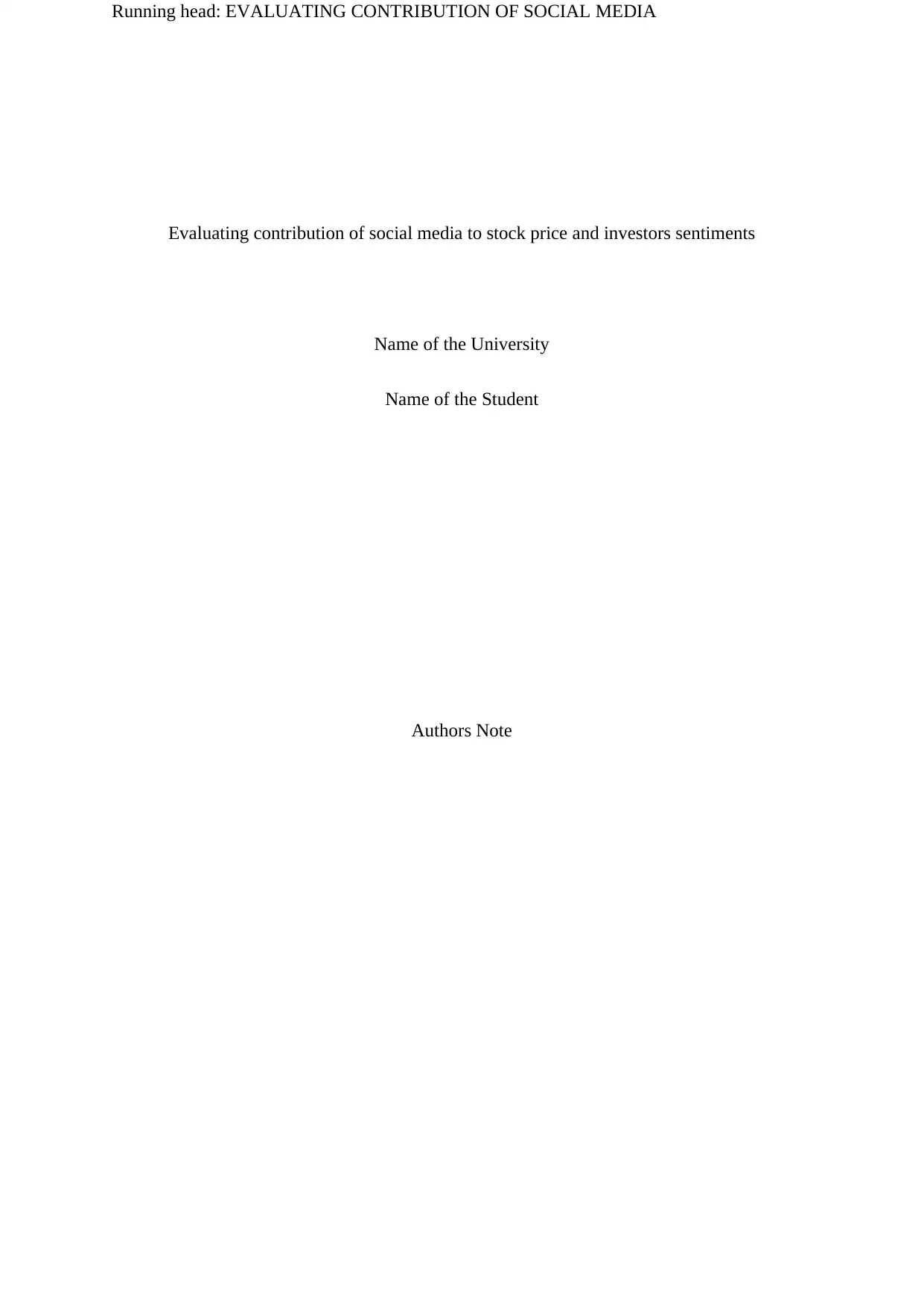
Running head: EVALUATING CONTRIBUTION OF SOCIAL MEDIA
Evaluating contribution of social media to stock price and investors sentiments
Name of the University
Name of the Student
Authors Note
Evaluating contribution of social media to stock price and investors sentiments
Name of the University
Name of the Student
Authors Note
Paraphrase This Document
Need a fresh take? Get an instant paraphrase of this document with our AI Paraphraser
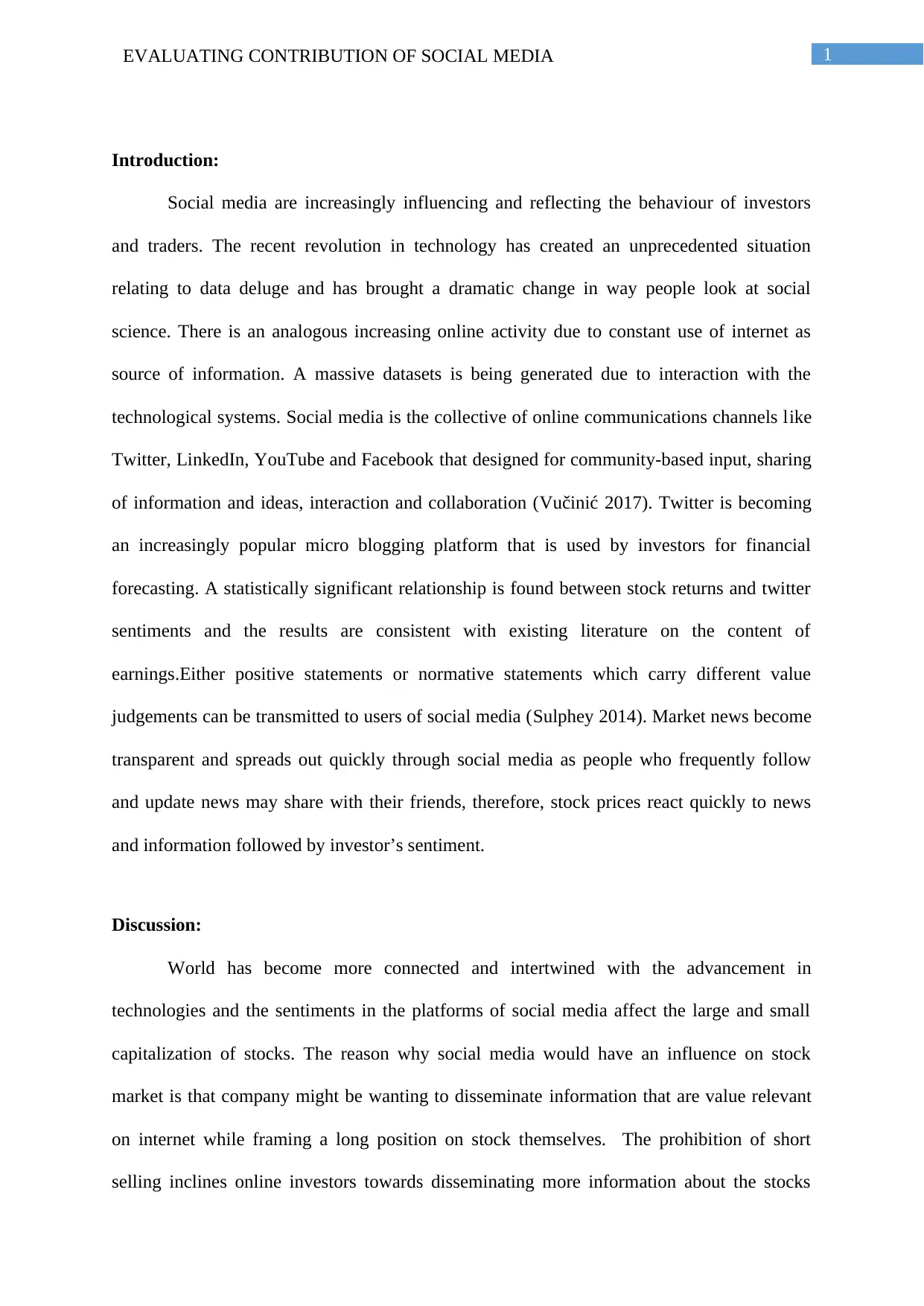
1EVALUATING CONTRIBUTION OF SOCIAL MEDIA
Introduction:
Social media are increasingly influencing and reflecting the behaviour of investors
and traders. The recent revolution in technology has created an unprecedented situation
relating to data deluge and has brought a dramatic change in way people look at social
science. There is an analogous increasing online activity due to constant use of internet as
source of information. A massive datasets is being generated due to interaction with the
technological systems. Social media is the collective of online communications channels like
Twitter, LinkedIn, YouTube and Facebook that designed for community-based input, sharing
of information and ideas, interaction and collaboration (Vučinić 2017). Twitter is becoming
an increasingly popular micro blogging platform that is used by investors for financial
forecasting. A statistically significant relationship is found between stock returns and twitter
sentiments and the results are consistent with existing literature on the content of
earnings.Either positive statements or normative statements which carry different value
judgements can be transmitted to users of social media (Sulphey 2014). Market news become
transparent and spreads out quickly through social media as people who frequently follow
and update news may share with their friends, therefore, stock prices react quickly to news
and information followed by investor’s sentiment.
Discussion:
World has become more connected and intertwined with the advancement in
technologies and the sentiments in the platforms of social media affect the large and small
capitalization of stocks. The reason why social media would have an influence on stock
market is that company might be wanting to disseminate information that are value relevant
on internet while framing a long position on stock themselves. The prohibition of short
selling inclines online investors towards disseminating more information about the stocks
Introduction:
Social media are increasingly influencing and reflecting the behaviour of investors
and traders. The recent revolution in technology has created an unprecedented situation
relating to data deluge and has brought a dramatic change in way people look at social
science. There is an analogous increasing online activity due to constant use of internet as
source of information. A massive datasets is being generated due to interaction with the
technological systems. Social media is the collective of online communications channels like
Twitter, LinkedIn, YouTube and Facebook that designed for community-based input, sharing
of information and ideas, interaction and collaboration (Vučinić 2017). Twitter is becoming
an increasingly popular micro blogging platform that is used by investors for financial
forecasting. A statistically significant relationship is found between stock returns and twitter
sentiments and the results are consistent with existing literature on the content of
earnings.Either positive statements or normative statements which carry different value
judgements can be transmitted to users of social media (Sulphey 2014). Market news become
transparent and spreads out quickly through social media as people who frequently follow
and update news may share with their friends, therefore, stock prices react quickly to news
and information followed by investor’s sentiment.
Discussion:
World has become more connected and intertwined with the advancement in
technologies and the sentiments in the platforms of social media affect the large and small
capitalization of stocks. The reason why social media would have an influence on stock
market is that company might be wanting to disseminate information that are value relevant
on internet while framing a long position on stock themselves. The prohibition of short
selling inclines online investors towards disseminating more information about the stocks
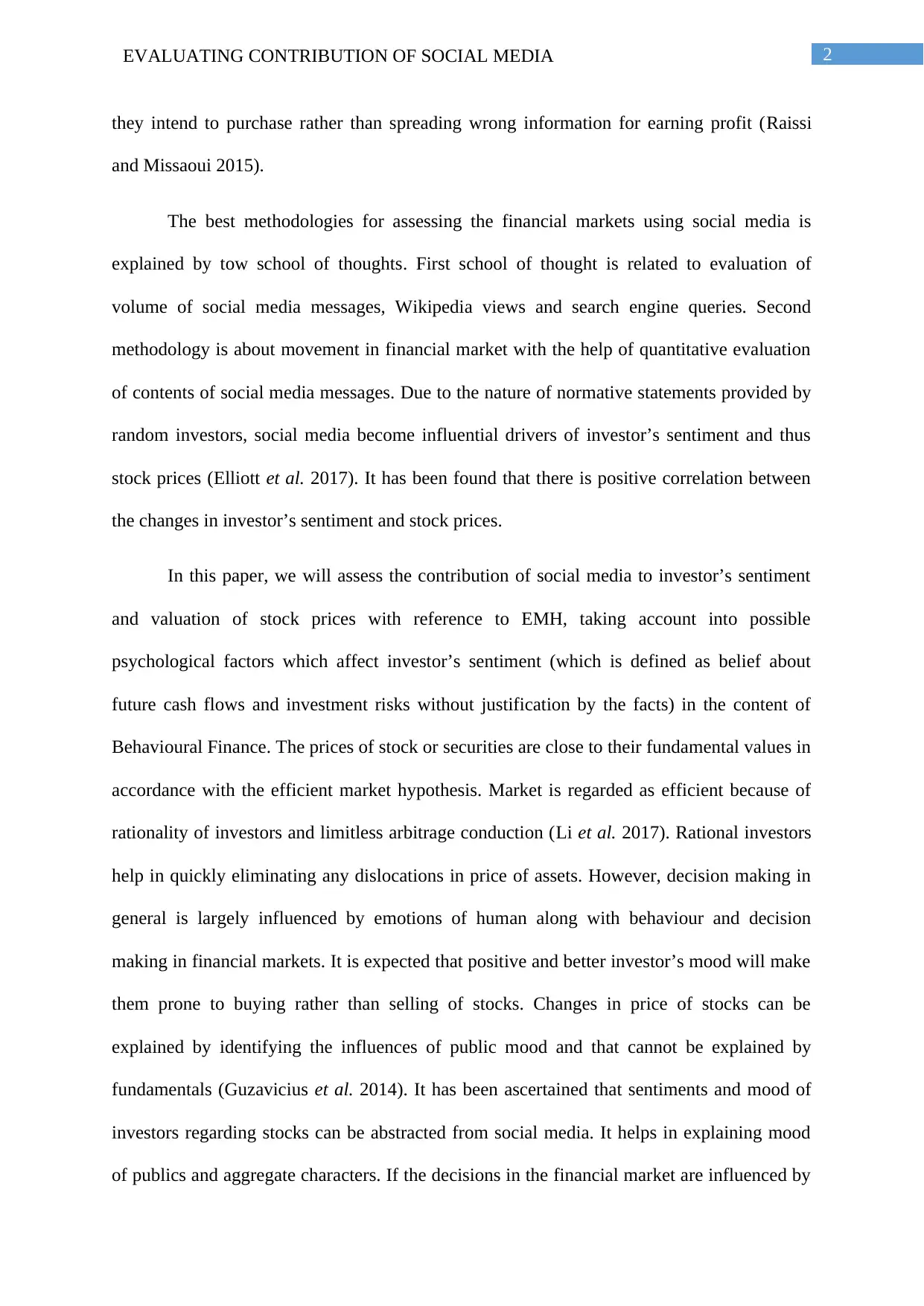
2EVALUATING CONTRIBUTION OF SOCIAL MEDIA
they intend to purchase rather than spreading wrong information for earning profit (Raissi
and Missaoui 2015).
The best methodologies for assessing the financial markets using social media is
explained by tow school of thoughts. First school of thought is related to evaluation of
volume of social media messages, Wikipedia views and search engine queries. Second
methodology is about movement in financial market with the help of quantitative evaluation
of contents of social media messages. Due to the nature of normative statements provided by
random investors, social media become influential drivers of investor’s sentiment and thus
stock prices (Elliott et al. 2017). It has been found that there is positive correlation between
the changes in investor’s sentiment and stock prices.
In this paper, we will assess the contribution of social media to investor’s sentiment
and valuation of stock prices with reference to EMH, taking account into possible
psychological factors which affect investor’s sentiment (which is defined as belief about
future cash flows and investment risks without justification by the facts) in the content of
Behavioural Finance. The prices of stock or securities are close to their fundamental values in
accordance with the efficient market hypothesis. Market is regarded as efficient because of
rationality of investors and limitless arbitrage conduction (Li et al. 2017). Rational investors
help in quickly eliminating any dislocations in price of assets. However, decision making in
general is largely influenced by emotions of human along with behaviour and decision
making in financial markets. It is expected that positive and better investor’s mood will make
them prone to buying rather than selling of stocks. Changes in price of stocks can be
explained by identifying the influences of public mood and that cannot be explained by
fundamentals (Guzavicius et al. 2014). It has been ascertained that sentiments and mood of
investors regarding stocks can be abstracted from social media. It helps in explaining mood
of publics and aggregate characters. If the decisions in the financial market are influenced by
they intend to purchase rather than spreading wrong information for earning profit (Raissi
and Missaoui 2015).
The best methodologies for assessing the financial markets using social media is
explained by tow school of thoughts. First school of thought is related to evaluation of
volume of social media messages, Wikipedia views and search engine queries. Second
methodology is about movement in financial market with the help of quantitative evaluation
of contents of social media messages. Due to the nature of normative statements provided by
random investors, social media become influential drivers of investor’s sentiment and thus
stock prices (Elliott et al. 2017). It has been found that there is positive correlation between
the changes in investor’s sentiment and stock prices.
In this paper, we will assess the contribution of social media to investor’s sentiment
and valuation of stock prices with reference to EMH, taking account into possible
psychological factors which affect investor’s sentiment (which is defined as belief about
future cash flows and investment risks without justification by the facts) in the content of
Behavioural Finance. The prices of stock or securities are close to their fundamental values in
accordance with the efficient market hypothesis. Market is regarded as efficient because of
rationality of investors and limitless arbitrage conduction (Li et al. 2017). Rational investors
help in quickly eliminating any dislocations in price of assets. However, decision making in
general is largely influenced by emotions of human along with behaviour and decision
making in financial markets. It is expected that positive and better investor’s mood will make
them prone to buying rather than selling of stocks. Changes in price of stocks can be
explained by identifying the influences of public mood and that cannot be explained by
fundamentals (Guzavicius et al. 2014). It has been ascertained that sentiments and mood of
investors regarding stocks can be abstracted from social media. It helps in explaining mood
of publics and aggregate characters. If the decisions in the financial market are influenced by
⊘ This is a preview!⊘
Do you want full access?
Subscribe today to unlock all pages.

Trusted by 1+ million students worldwide
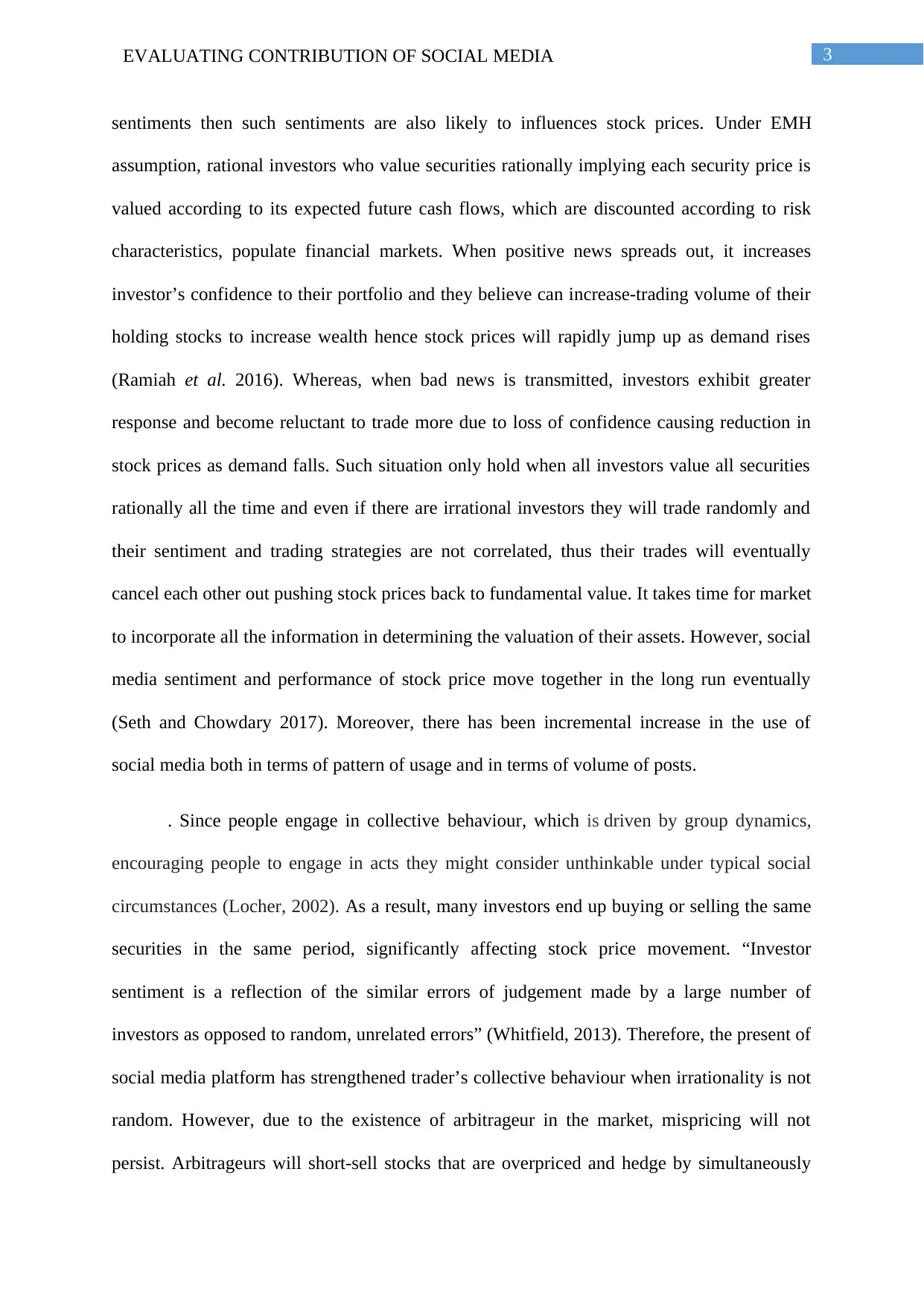
3EVALUATING CONTRIBUTION OF SOCIAL MEDIA
sentiments then such sentiments are also likely to influences stock prices. Under EMH
assumption, rational investors who value securities rationally implying each security price is
valued according to its expected future cash flows, which are discounted according to risk
characteristics, populate financial markets. When positive news spreads out, it increases
investor’s confidence to their portfolio and they believe can increase-trading volume of their
holding stocks to increase wealth hence stock prices will rapidly jump up as demand rises
(Ramiah et al. 2016). Whereas, when bad news is transmitted, investors exhibit greater
response and become reluctant to trade more due to loss of confidence causing reduction in
stock prices as demand falls. Such situation only hold when all investors value all securities
rationally all the time and even if there are irrational investors they will trade randomly and
their sentiment and trading strategies are not correlated, thus their trades will eventually
cancel each other out pushing stock prices back to fundamental value. It takes time for market
to incorporate all the information in determining the valuation of their assets. However, social
media sentiment and performance of stock price move together in the long run eventually
(Seth and Chowdary 2017). Moreover, there has been incremental increase in the use of
social media both in terms of pattern of usage and in terms of volume of posts.
. Since people engage in collective behaviour, which is driven by group dynamics,
encouraging people to engage in acts they might consider unthinkable under typical social
circumstances (Locher, 2002). As a result, many investors end up buying or selling the same
securities in the same period, significantly affecting stock price movement. “Investor
sentiment is a reflection of the similar errors of judgement made by a large number of
investors as opposed to random, unrelated errors” (Whitfield, 2013). Therefore, the present of
social media platform has strengthened trader’s collective behaviour when irrationality is not
random. However, due to the existence of arbitrageur in the market, mispricing will not
persist. Arbitrageurs will short-sell stocks that are overpriced and hedge by simultaneously
sentiments then such sentiments are also likely to influences stock prices. Under EMH
assumption, rational investors who value securities rationally implying each security price is
valued according to its expected future cash flows, which are discounted according to risk
characteristics, populate financial markets. When positive news spreads out, it increases
investor’s confidence to their portfolio and they believe can increase-trading volume of their
holding stocks to increase wealth hence stock prices will rapidly jump up as demand rises
(Ramiah et al. 2016). Whereas, when bad news is transmitted, investors exhibit greater
response and become reluctant to trade more due to loss of confidence causing reduction in
stock prices as demand falls. Such situation only hold when all investors value all securities
rationally all the time and even if there are irrational investors they will trade randomly and
their sentiment and trading strategies are not correlated, thus their trades will eventually
cancel each other out pushing stock prices back to fundamental value. It takes time for market
to incorporate all the information in determining the valuation of their assets. However, social
media sentiment and performance of stock price move together in the long run eventually
(Seth and Chowdary 2017). Moreover, there has been incremental increase in the use of
social media both in terms of pattern of usage and in terms of volume of posts.
. Since people engage in collective behaviour, which is driven by group dynamics,
encouraging people to engage in acts they might consider unthinkable under typical social
circumstances (Locher, 2002). As a result, many investors end up buying or selling the same
securities in the same period, significantly affecting stock price movement. “Investor
sentiment is a reflection of the similar errors of judgement made by a large number of
investors as opposed to random, unrelated errors” (Whitfield, 2013). Therefore, the present of
social media platform has strengthened trader’s collective behaviour when irrationality is not
random. However, due to the existence of arbitrageur in the market, mispricing will not
persist. Arbitrageurs will short-sell stocks that are overpriced and hedge by simultaneously
Paraphrase This Document
Need a fresh take? Get an instant paraphrase of this document with our AI Paraphraser
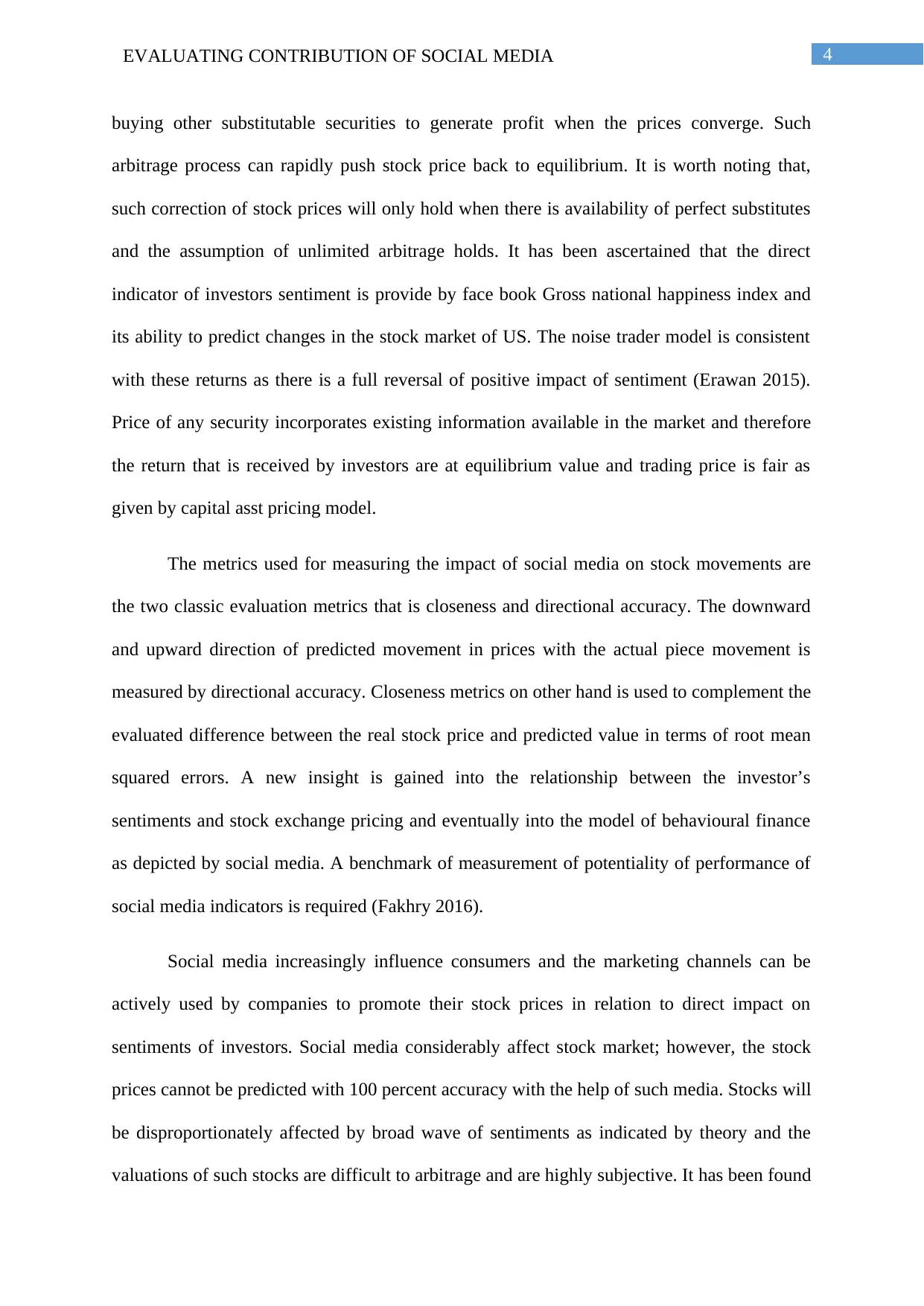
4EVALUATING CONTRIBUTION OF SOCIAL MEDIA
buying other substitutable securities to generate profit when the prices converge. Such
arbitrage process can rapidly push stock price back to equilibrium. It is worth noting that,
such correction of stock prices will only hold when there is availability of perfect substitutes
and the assumption of unlimited arbitrage holds. It has been ascertained that the direct
indicator of investors sentiment is provide by face book Gross national happiness index and
its ability to predict changes in the stock market of US. The noise trader model is consistent
with these returns as there is a full reversal of positive impact of sentiment (Erawan 2015).
Price of any security incorporates existing information available in the market and therefore
the return that is received by investors are at equilibrium value and trading price is fair as
given by capital asst pricing model.
The metrics used for measuring the impact of social media on stock movements are
the two classic evaluation metrics that is closeness and directional accuracy. The downward
and upward direction of predicted movement in prices with the actual piece movement is
measured by directional accuracy. Closeness metrics on other hand is used to complement the
evaluated difference between the real stock price and predicted value in terms of root mean
squared errors. A new insight is gained into the relationship between the investor’s
sentiments and stock exchange pricing and eventually into the model of behavioural finance
as depicted by social media. A benchmark of measurement of potentiality of performance of
social media indicators is required (Fakhry 2016).
Social media increasingly influence consumers and the marketing channels can be
actively used by companies to promote their stock prices in relation to direct impact on
sentiments of investors. Social media considerably affect stock market; however, the stock
prices cannot be predicted with 100 percent accuracy with the help of such media. Stocks will
be disproportionately affected by broad wave of sentiments as indicated by theory and the
valuations of such stocks are difficult to arbitrage and are highly subjective. It has been found
buying other substitutable securities to generate profit when the prices converge. Such
arbitrage process can rapidly push stock price back to equilibrium. It is worth noting that,
such correction of stock prices will only hold when there is availability of perfect substitutes
and the assumption of unlimited arbitrage holds. It has been ascertained that the direct
indicator of investors sentiment is provide by face book Gross national happiness index and
its ability to predict changes in the stock market of US. The noise trader model is consistent
with these returns as there is a full reversal of positive impact of sentiment (Erawan 2015).
Price of any security incorporates existing information available in the market and therefore
the return that is received by investors are at equilibrium value and trading price is fair as
given by capital asst pricing model.
The metrics used for measuring the impact of social media on stock movements are
the two classic evaluation metrics that is closeness and directional accuracy. The downward
and upward direction of predicted movement in prices with the actual piece movement is
measured by directional accuracy. Closeness metrics on other hand is used to complement the
evaluated difference between the real stock price and predicted value in terms of root mean
squared errors. A new insight is gained into the relationship between the investor’s
sentiments and stock exchange pricing and eventually into the model of behavioural finance
as depicted by social media. A benchmark of measurement of potentiality of performance of
social media indicators is required (Fakhry 2016).
Social media increasingly influence consumers and the marketing channels can be
actively used by companies to promote their stock prices in relation to direct impact on
sentiments of investors. Social media considerably affect stock market; however, the stock
prices cannot be predicted with 100 percent accuracy with the help of such media. Stocks will
be disproportionately affected by broad wave of sentiments as indicated by theory and the
valuations of such stocks are difficult to arbitrage and are highly subjective. It has been found
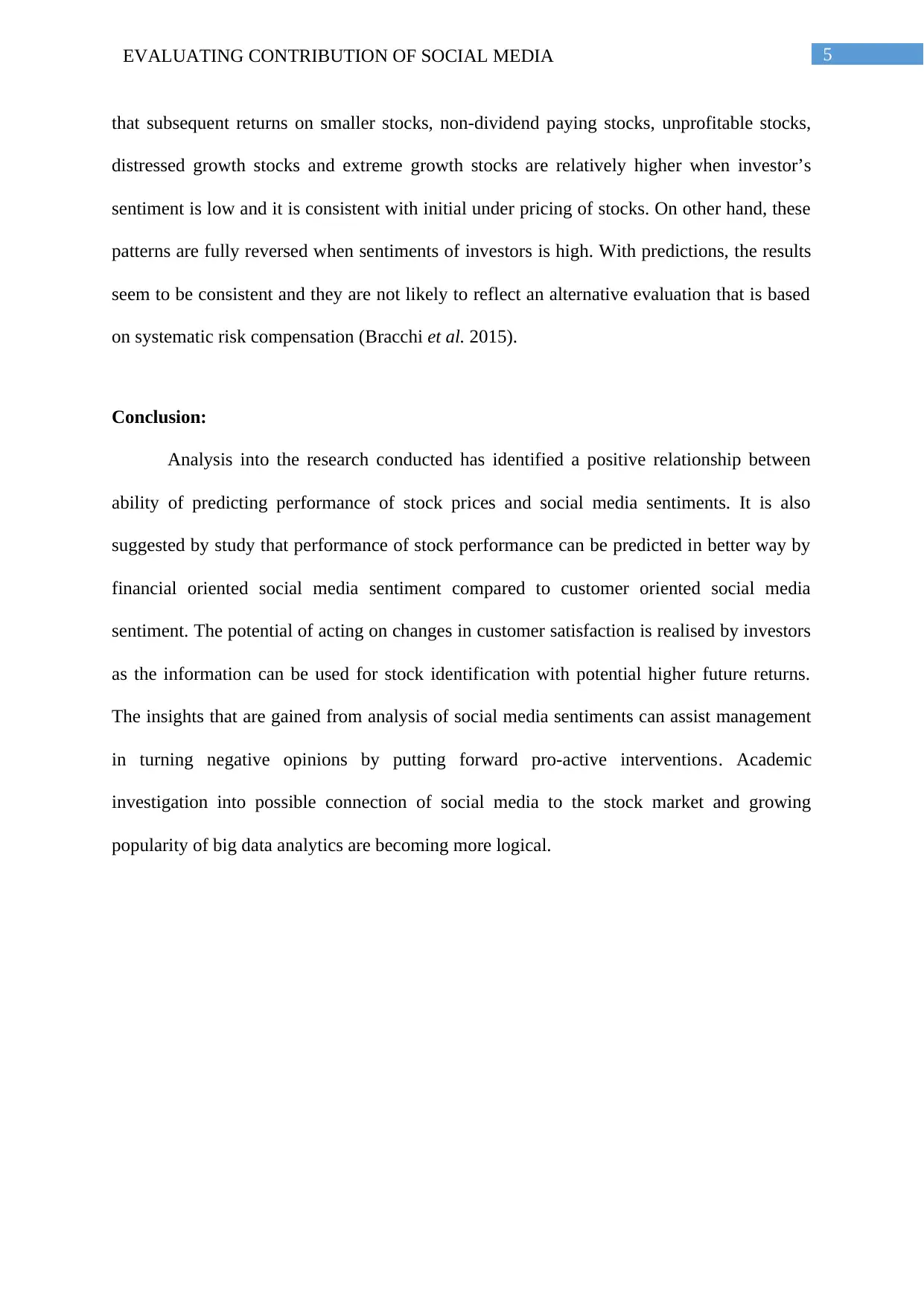
5EVALUATING CONTRIBUTION OF SOCIAL MEDIA
that subsequent returns on smaller stocks, non-dividend paying stocks, unprofitable stocks,
distressed growth stocks and extreme growth stocks are relatively higher when investor’s
sentiment is low and it is consistent with initial under pricing of stocks. On other hand, these
patterns are fully reversed when sentiments of investors is high. With predictions, the results
seem to be consistent and they are not likely to reflect an alternative evaluation that is based
on systematic risk compensation (Bracchi et al. 2015).
Conclusion:
Analysis into the research conducted has identified a positive relationship between
ability of predicting performance of stock prices and social media sentiments. It is also
suggested by study that performance of stock performance can be predicted in better way by
financial oriented social media sentiment compared to customer oriented social media
sentiment. The potential of acting on changes in customer satisfaction is realised by investors
as the information can be used for stock identification with potential higher future returns.
The insights that are gained from analysis of social media sentiments can assist management
in turning negative opinions by putting forward pro-active interventions. Academic
investigation into possible connection of social media to the stock market and growing
popularity of big data analytics are becoming more logical.
that subsequent returns on smaller stocks, non-dividend paying stocks, unprofitable stocks,
distressed growth stocks and extreme growth stocks are relatively higher when investor’s
sentiment is low and it is consistent with initial under pricing of stocks. On other hand, these
patterns are fully reversed when sentiments of investors is high. With predictions, the results
seem to be consistent and they are not likely to reflect an alternative evaluation that is based
on systematic risk compensation (Bracchi et al. 2015).
Conclusion:
Analysis into the research conducted has identified a positive relationship between
ability of predicting performance of stock prices and social media sentiments. It is also
suggested by study that performance of stock performance can be predicted in better way by
financial oriented social media sentiment compared to customer oriented social media
sentiment. The potential of acting on changes in customer satisfaction is realised by investors
as the information can be used for stock identification with potential higher future returns.
The insights that are gained from analysis of social media sentiments can assist management
in turning negative opinions by putting forward pro-active interventions. Academic
investigation into possible connection of social media to the stock market and growing
popularity of big data analytics are becoming more logical.
⊘ This is a preview!⊘
Do you want full access?
Subscribe today to unlock all pages.

Trusted by 1+ million students worldwide
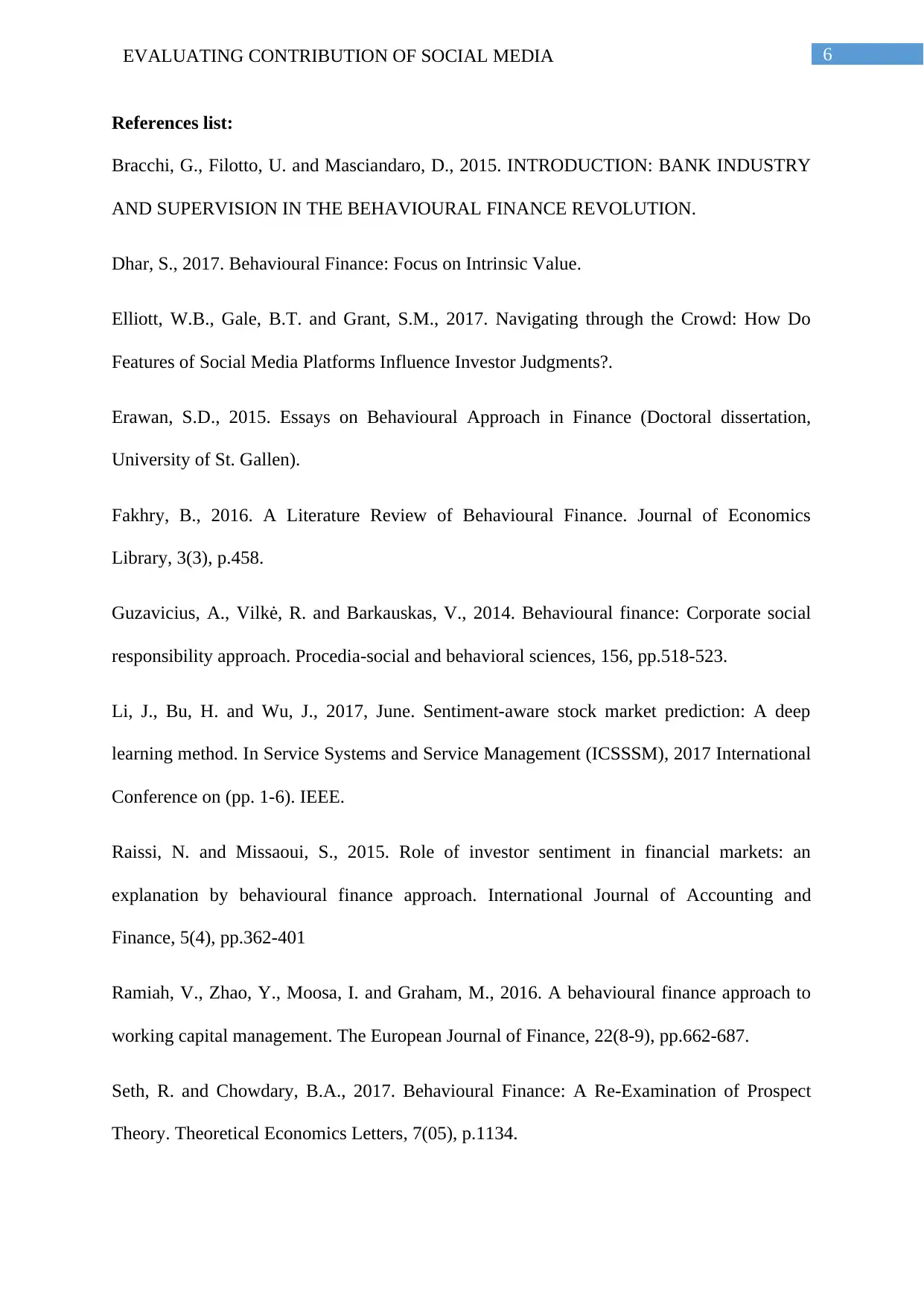
6EVALUATING CONTRIBUTION OF SOCIAL MEDIA
References list:
Bracchi, G., Filotto, U. and Masciandaro, D., 2015. INTRODUCTION: BANK INDUSTRY
AND SUPERVISION IN THE BEHAVIOURAL FINANCE REVOLUTION.
Dhar, S., 2017. Behavioural Finance: Focus on Intrinsic Value.
Elliott, W.B., Gale, B.T. and Grant, S.M., 2017. Navigating through the Crowd: How Do
Features of Social Media Platforms Influence Investor Judgments?.
Erawan, S.D., 2015. Essays on Behavioural Approach in Finance (Doctoral dissertation,
University of St. Gallen).
Fakhry, B., 2016. A Literature Review of Behavioural Finance. Journal of Economics
Library, 3(3), p.458.
Guzavicius, A., Vilkė, R. and Barkauskas, V., 2014. Behavioural finance: Corporate social
responsibility approach. Procedia-social and behavioral sciences, 156, pp.518-523.
Li, J., Bu, H. and Wu, J., 2017, June. Sentiment-aware stock market prediction: A deep
learning method. In Service Systems and Service Management (ICSSSM), 2017 International
Conference on (pp. 1-6). IEEE.
Raissi, N. and Missaoui, S., 2015. Role of investor sentiment in financial markets: an
explanation by behavioural finance approach. International Journal of Accounting and
Finance, 5(4), pp.362-401
Ramiah, V., Zhao, Y., Moosa, I. and Graham, M., 2016. A behavioural finance approach to
working capital management. The European Journal of Finance, 22(8-9), pp.662-687.
Seth, R. and Chowdary, B.A., 2017. Behavioural Finance: A Re-Examination of Prospect
Theory. Theoretical Economics Letters, 7(05), p.1134.
References list:
Bracchi, G., Filotto, U. and Masciandaro, D., 2015. INTRODUCTION: BANK INDUSTRY
AND SUPERVISION IN THE BEHAVIOURAL FINANCE REVOLUTION.
Dhar, S., 2017. Behavioural Finance: Focus on Intrinsic Value.
Elliott, W.B., Gale, B.T. and Grant, S.M., 2017. Navigating through the Crowd: How Do
Features of Social Media Platforms Influence Investor Judgments?.
Erawan, S.D., 2015. Essays on Behavioural Approach in Finance (Doctoral dissertation,
University of St. Gallen).
Fakhry, B., 2016. A Literature Review of Behavioural Finance. Journal of Economics
Library, 3(3), p.458.
Guzavicius, A., Vilkė, R. and Barkauskas, V., 2014. Behavioural finance: Corporate social
responsibility approach. Procedia-social and behavioral sciences, 156, pp.518-523.
Li, J., Bu, H. and Wu, J., 2017, June. Sentiment-aware stock market prediction: A deep
learning method. In Service Systems and Service Management (ICSSSM), 2017 International
Conference on (pp. 1-6). IEEE.
Raissi, N. and Missaoui, S., 2015. Role of investor sentiment in financial markets: an
explanation by behavioural finance approach. International Journal of Accounting and
Finance, 5(4), pp.362-401
Ramiah, V., Zhao, Y., Moosa, I. and Graham, M., 2016. A behavioural finance approach to
working capital management. The European Journal of Finance, 22(8-9), pp.662-687.
Seth, R. and Chowdary, B.A., 2017. Behavioural Finance: A Re-Examination of Prospect
Theory. Theoretical Economics Letters, 7(05), p.1134.
Paraphrase This Document
Need a fresh take? Get an instant paraphrase of this document with our AI Paraphraser

7EVALUATING CONTRIBUTION OF SOCIAL MEDIA
Sulphey, M.M., 2014. Behavioural Finance. PHI Learning Pvt. Ltd..
Vučinić, M., 2017. Behavioural finance and its postulates. Management: Journal of
Sustainable Business and Management Solutions in Emerging Economies, 21(80), pp.67-76.
Sulphey, M.M., 2014. Behavioural Finance. PHI Learning Pvt. Ltd..
Vučinić, M., 2017. Behavioural finance and its postulates. Management: Journal of
Sustainable Business and Management Solutions in Emerging Economies, 21(80), pp.67-76.
1 out of 8
Related Documents
Your All-in-One AI-Powered Toolkit for Academic Success.
+13062052269
info@desklib.com
Available 24*7 on WhatsApp / Email
![[object Object]](/_next/static/media/star-bottom.7253800d.svg)
Unlock your academic potential
Copyright © 2020–2025 A2Z Services. All Rights Reserved. Developed and managed by ZUCOL.





